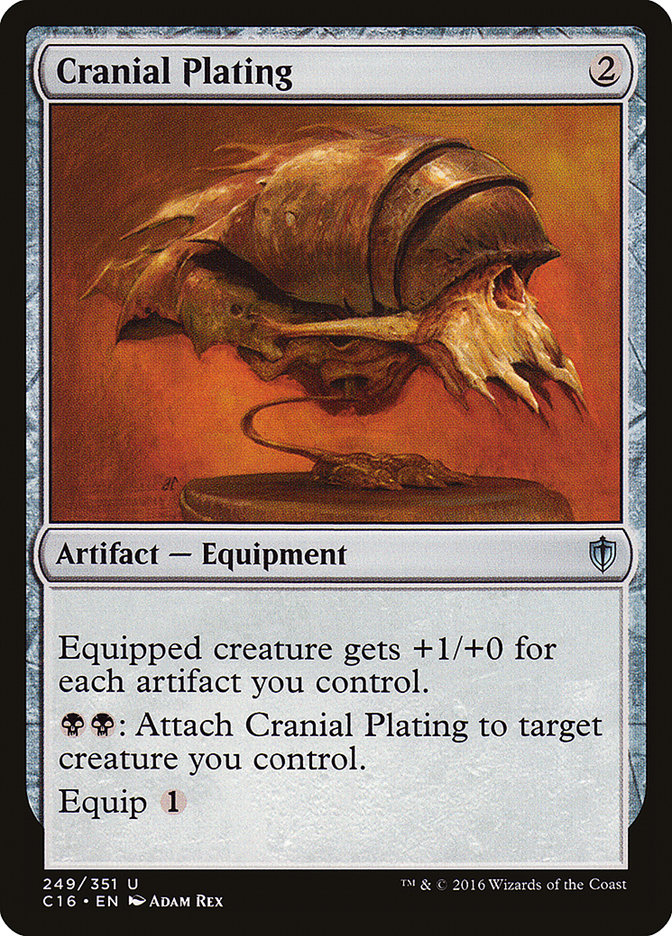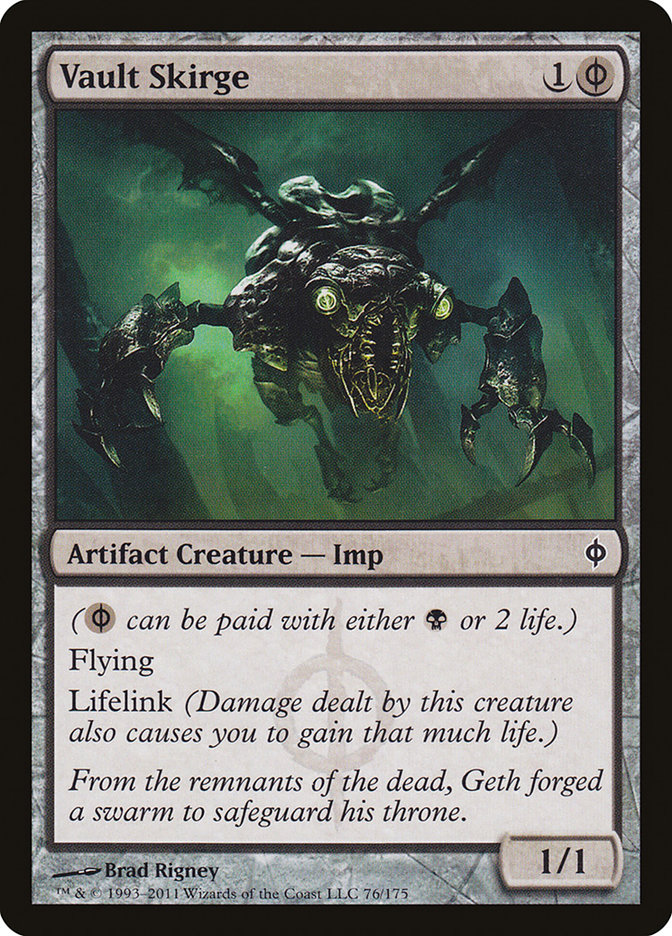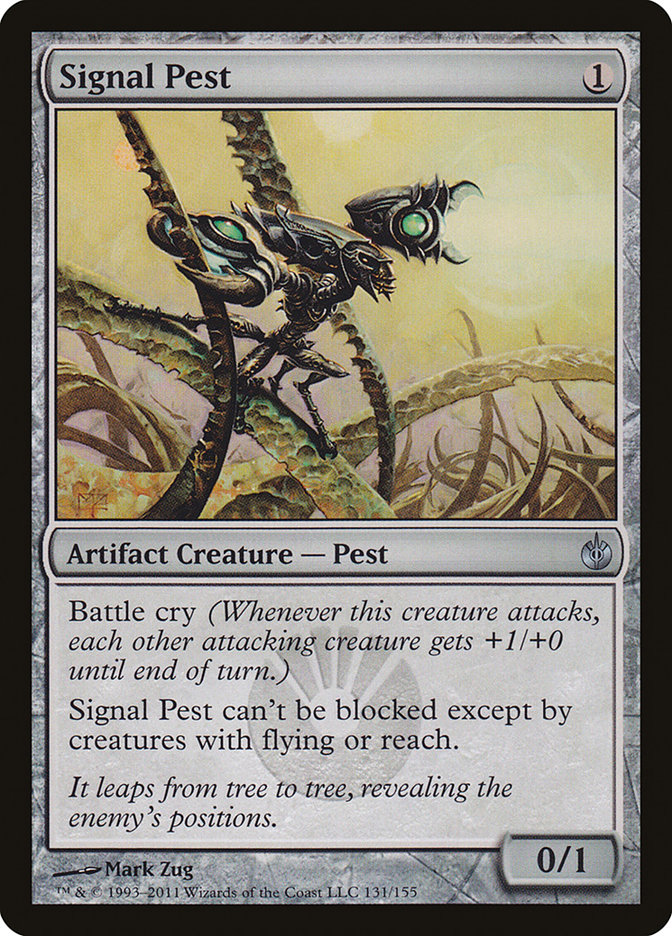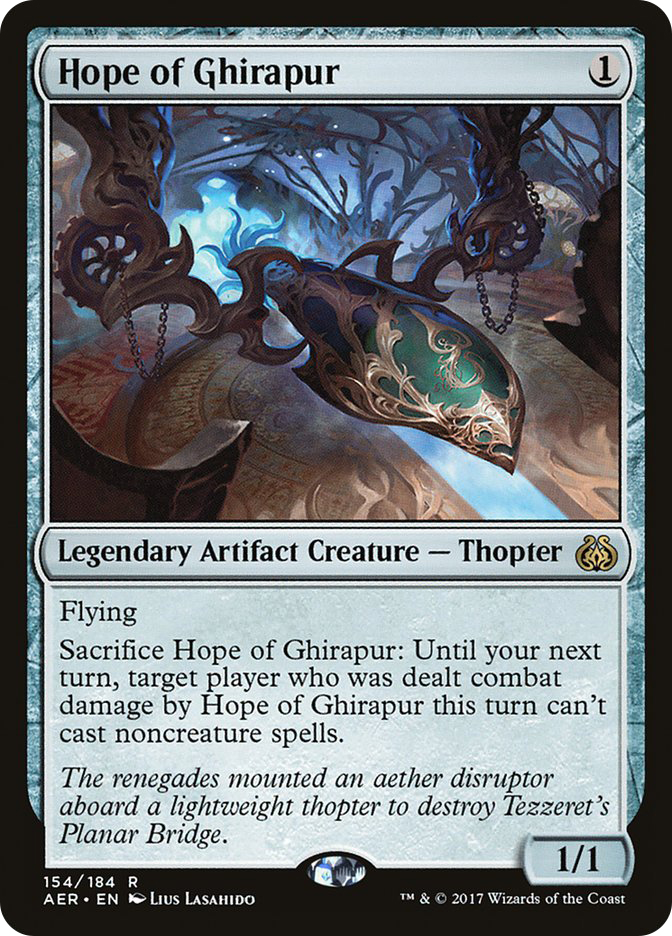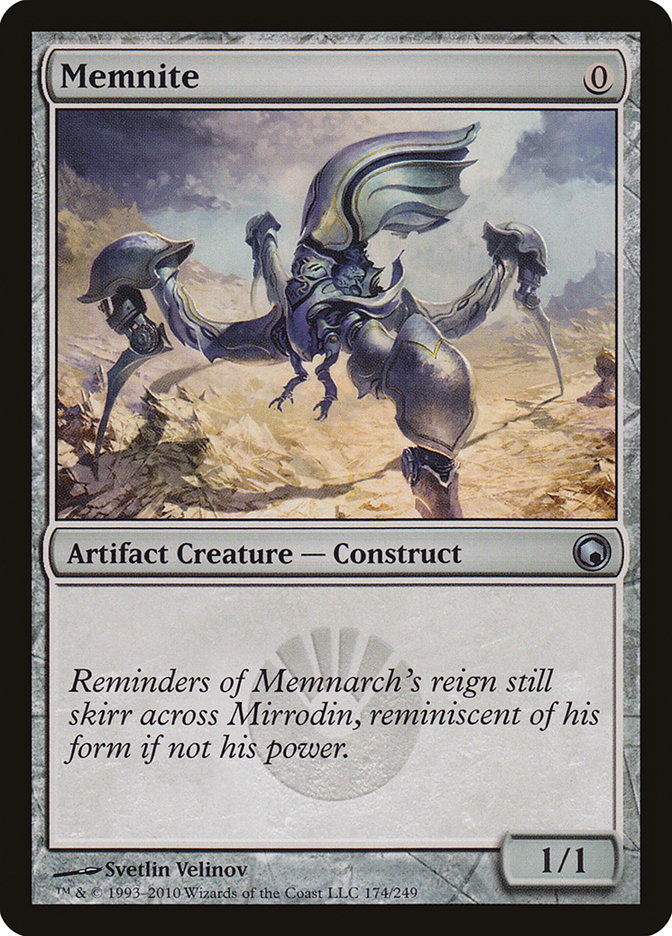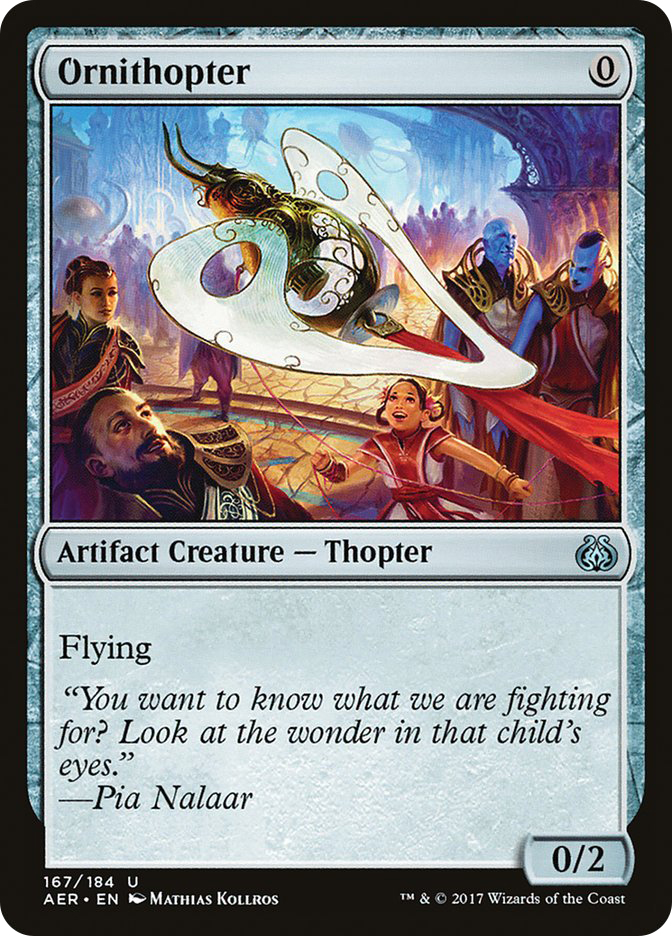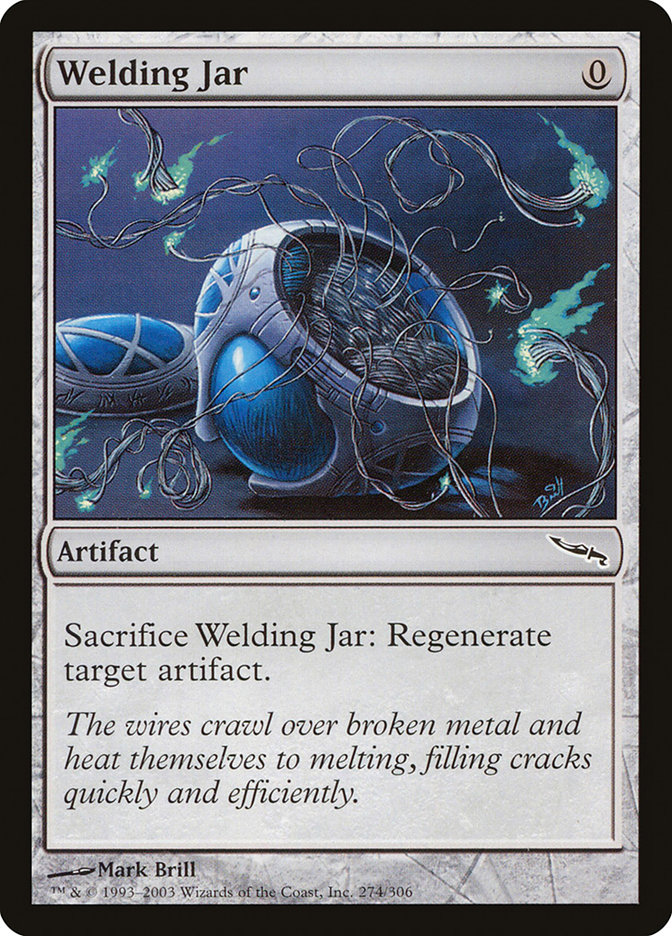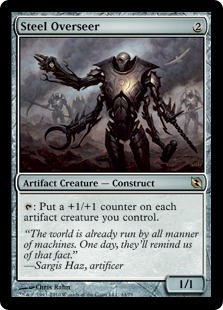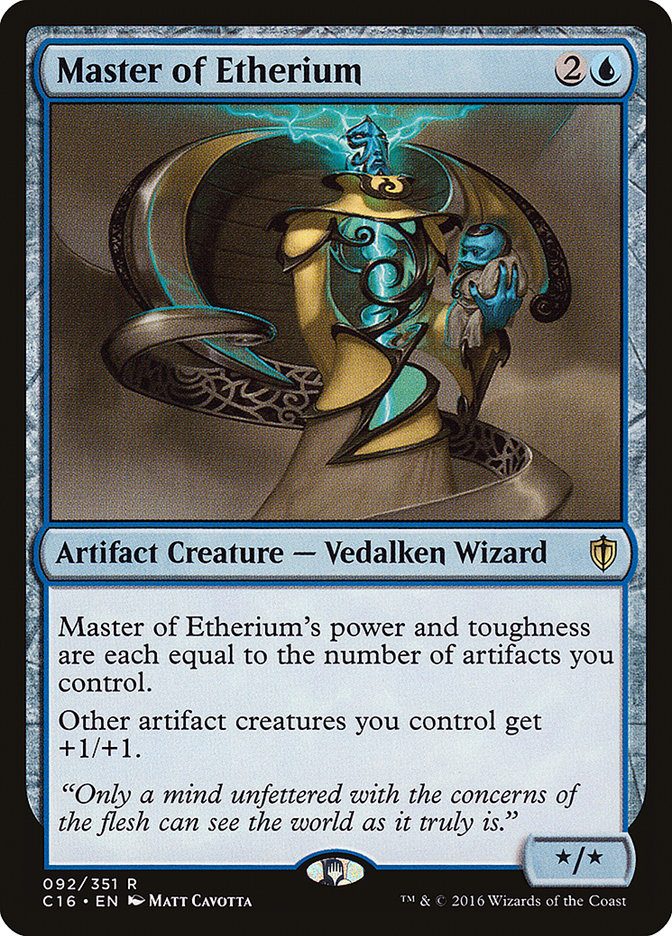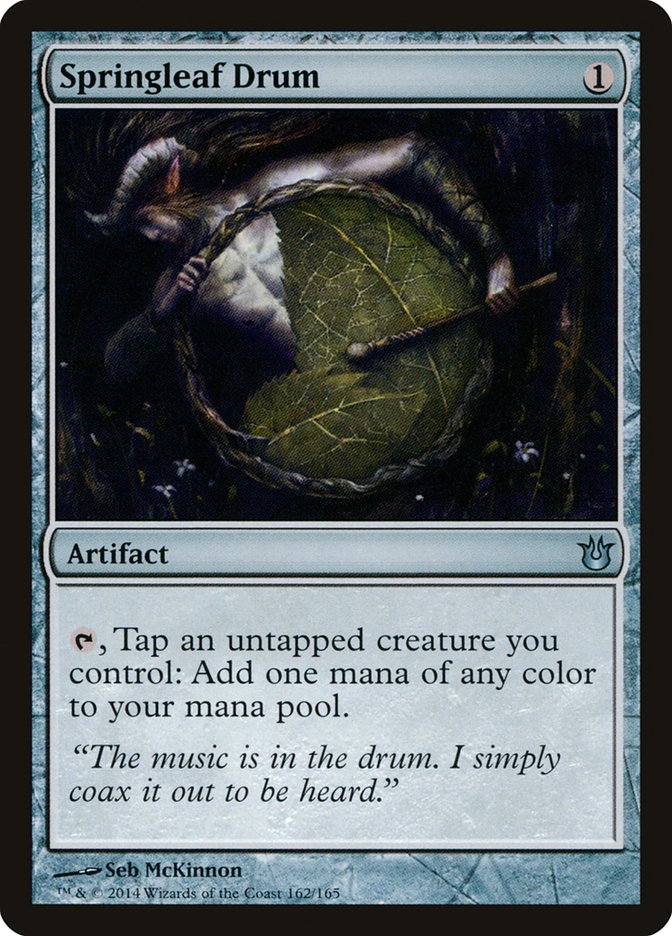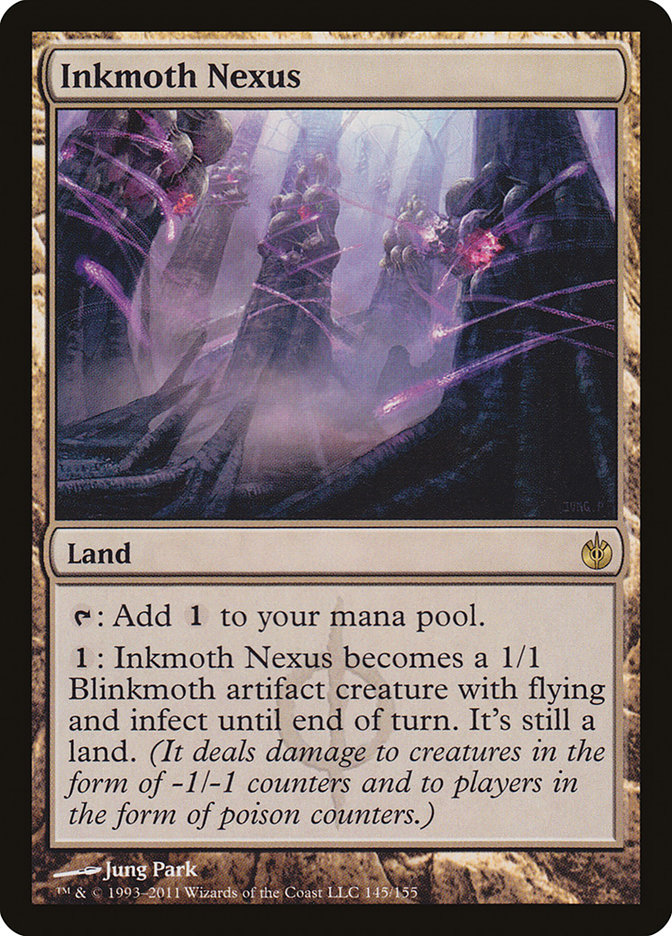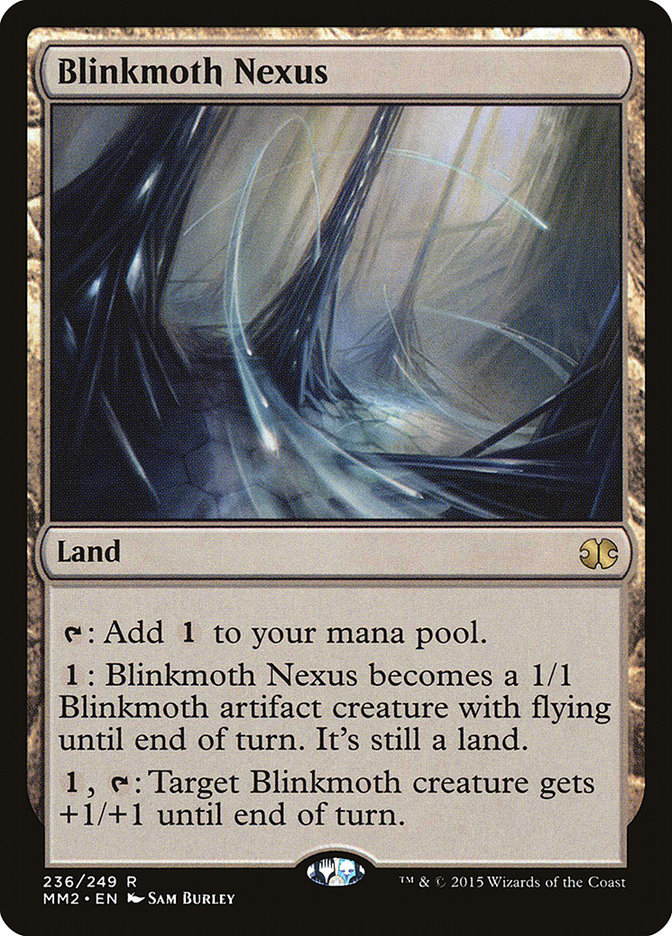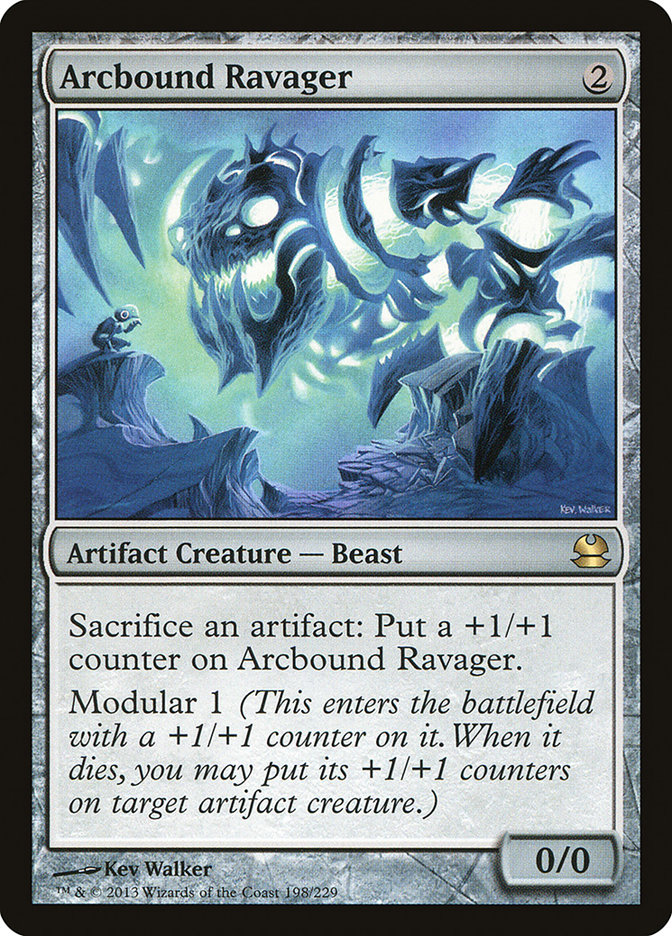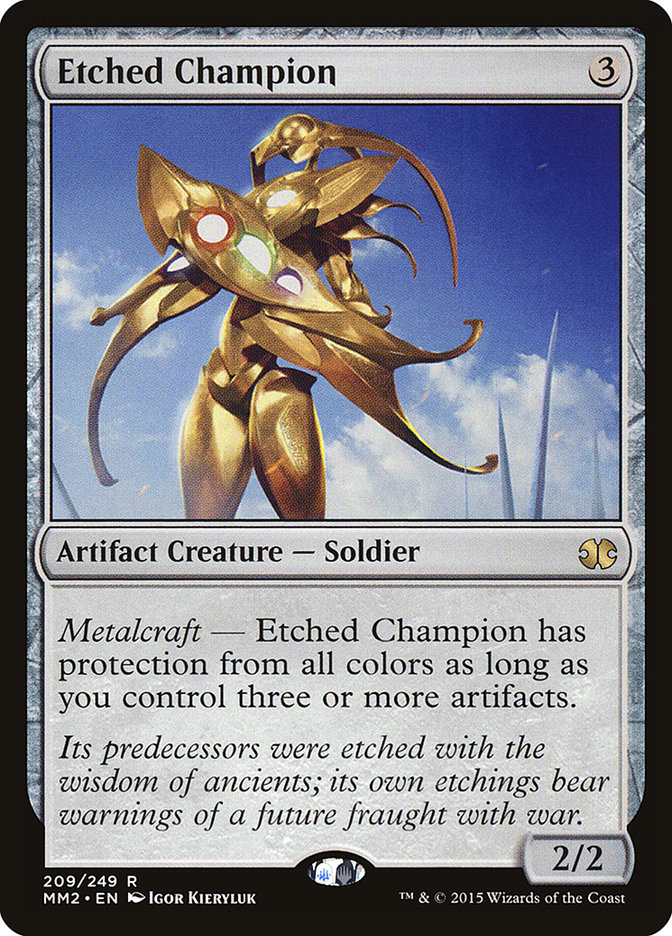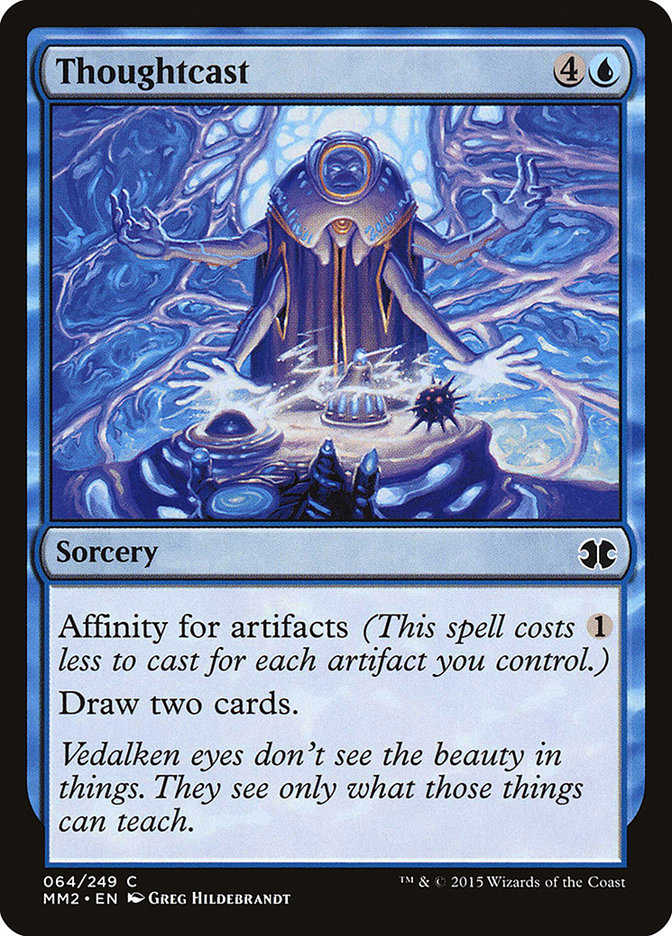Two weekends ago, I went 11-2 at Grand Prix Santa Clara with Affinity.
Yeah, it was a team tournament. Yeah, I’m counting individual record. But
Team Constructed is honestly closer to three correlated solo events than
classic Team Sealed. I didn’t take all the rares from the pool, I just
practiced Affinity and beat people up with it.
The list was delivered to me by Andrew Elenbogen, who Top 8’ed the
StarcityGames Classic in Columbus that weekend with a very similar list.
For simplicity, this is the list I would be playing tomorrow.
Creatures (26)
- 4 Arcbound Ravager
- 4 Ornithopter
- 2 Master of Etherium
- 3 Steel Overseer
- 3 Memnite
- 2 Etched Champion
- 4 Signal Pest
- 3 Vault Skirge
- 1 Hope of Ghirapur
Lands (16)
Spells (18)
Sideboard

It’s been a while since anyone did a real deep dive into Affinity, but the
deck has just been great forever so it deserves a refresh.
The Outline
Affinity is a shark. It does the thing it does so well it hasn’t had to
change.
It’s also a deck where nothing is sacred. Well, Mox Opal is locked in until
it gets banned, but the rest of the deck isn’t. You play a bunch of cheap
artifacts, they make a couple cards busted, your opponent dies. The
enablers and win conditions are largely interchangeable, meaning it’s
really possible you could end up with a completely new “Affinity deck” by
changing some of them and adjusting the rest to maximize those cards.
So with that in mind, let’s talk about why the existing list grew to what
it is. It’s easy to pick up the deck, draw a bunch of Memnites, and wonder
why things are the way they are.
Cranial Plating is basically the start of it all. It is… uhh… really dumb.
Cranial Plating means you need cheap, evasive bodies.
It means your zero-drops should be creatures.
Oh look, we now want payoffs that play to us having more creatures.
Springleaf Drum might deserve a higher billing on power level, but it’s
another fallout of creature-heavy strategies. It also doubles up with Mox
Opal to put you into a range where you can reliably exploit early three
mana turns.
Adding mana means you want your lands to convert into other resources. Also
Inkmoth Nexus is really dumb in your power pumping deck.
Honestly, if Inkmoth Nexus didn’t exist I might look at cutting Arcbound
Ravager, but that combo creates most of your turn 3 kills, so Ravager is
just locked in.
If you start chipping away beyond the locked in minimums, these are the
assumptions you are attacking. It might be right for some reason, but make sure your upstream
and downstream logic adjusts with any cuts.
Now to bare minimum numbers. This is basically what the deck has optimized
to over six years of Modern. Unless you’re making some very fundamental
changes, I wouldn’t mess with them.
- Sixteen land
- Eight fast mana (Mox Opal, Springleaf Drum)
- Six zero-drop creatures, probably a seventh zero-drop of some kind.
- Eight one-drops
- Eight large pump effects (Arcbound Ravager, Cranial Plating)
- Four other standalone threats (Master of Etherium, Steel Overseer)
That’s 51 locked in slots, leaving nine. I currently have two extra
zero-drops (Memnite and Welding Jar) instead of the minimum one, two Etched
Champions, a land, four Galvanic Blast, and an extra threat from the
minimum.
Now to discuss maximums.
More than six cards that don’t enable a fast start (cheap artifacts) or
aren’t payoffs that win the game on their own starts making your deck have
bad hands. For example, this hand has some good cards but really won’t beat
anyone. Unless you know your opponent is playing a deck that can’t beat
Etched Champion just hanging out, I would mulligan this hand.


Keep hands that have finishers and clock people, not random garbage piles.
You should very rarely sideboard into more than six three-drops. In my
current list this turns into a maindeck cap of four as I often want all the
Etched Champions and Master of Etherium.
You should try to keep to eight or less spells that require colored mana
post-sideboard, but this rule is a bit looser. A similar useful rule is
that when given a close choice between sideboarding out a colorless card
and a colored one, keep the colorless card.
Card Specifics
From my current list, you often cut exactly one of these in sideboarding.
If they have ground blockers or fliers to block, it’s Memnite. If they
don’t have removal it stops, it’s Welding Jar. If having one power matters,
like versus Jeskai, it’s Ornithopter. Often if you are just goldfishing
it’s keep all eight.
As for Welding Jar, I just love that card. Feel free to cut it from the
deck, especially since there aren’t a ton of Abrupt Decays.
First off, Hope of Ghirapur was great. I specifically cut Vault Skirge, as
in multiples it can often be difficult to recoup the life loss in games it
matters, like Burn and Scapeshift. You can pay the black mana for it, but
that’s clunky and awkward.
If you plan on sacrificing Hope of Ghirapur, be sure the turn matters. If
you’re stopping them from Storming off but can’t kill them next attack,
what’s the point? It might be better to hope they don’t kill you next turn,
Time Walk later, and then kill them. Maybe there’s some topdeck you open up
or you can put them low enough that a Blinkmoth Nexus can finish after a
Grapeshot sweep, but you need to figure that out ahead of time.
Signal Pest rides the line between one-drop and win condition. Let’s
reframe that prior “pile of garbage hand” with a Signal Pest.


That is seventeen damage by turn 4, which is easily a topdeck or aggressive
fetch away from real lethal. You have resiliency, interaction, and a clock.
That said, don’t run your 0/1 Signal Pests into their fliers. Against
Lingering Souls or mirrors they tend to come out.
Remember you can animate various Nexuses to add power via Cranial Plating.
Also remember that an animated Nexus with a Cranial Plating on it is an
artifact.
Example: You control the following permanents after some sweeper.

Animate an Inkmoth Nexus tapping Darksteel Citadel. Equip it with Cranial
Plating using Mox Opal. Tap the last Inkmoth Nexus to animate itself.
Attack for six infect.
The instant reequip on Cranial Plating is also really useful. Consider on
attacks if you have ways to use it to force lethal through a removal spell,
like starting Plating on your Ornithopter then swapping it to Vault Skirge
to keep a power.
Arcbound Ravager is the most complicated card in Affinity. Here’s the
thirty second summary:
If you have an extra artifact doing nothing, throw it into the Ravager on
the first attack to build up damage. This is usually extra mana or an
Ornithopter.
You can sacrifice Signal Pest after the battle cry trigger for a bonus
damage.
With multiple Ravagers, sacrificing one to another gives a “bonus” counter
via the sacrifice and the modular. If you have multiple Ravagers you can do
some cool spreading where you end up with several counters on one, modular
those over to a creature on sacrifice, then move the other Ravager’s
counters over to a different creature to make multiple large threats.
Steel Overseer counters on Arcbound Ravager move with modular. In the
reverse, Arcbound Ravager is a nonbo with Master of Etherium and Cranial
Plating. You can only get extra damage via the bonuses I mentioned.
Sometimes it’s just right to shove everything in and kill in two or three
attacks. Just think about how likely you are to win if the game goes
longer. If the answer isn’t good, especially if they just have that removal
spell, gun it.
Don’t forget to animate extra Nexuses to add counters to them before
activating Steel Overseer.
Steel Overseer is a liability against sweepers and Stony Silence, and often
just against decks where they can profitably pick off it but not your other
threats. It gets sideboarded out a lot. It’s still good.
I would not advise playing more than two Etched Champion in your maindeck
now, but I would want access to at least three and probably four
post-sideboard. The card doesn’t do anything on its own, but it is totally
unbeatable for some decks.
Against removal-heavy decks, I tend to play it real safe with my Etched
Champions. I often avoid casting them in spots where two removal spells
would take me off of metalcraft and then kill Champion or I’ll skip Nexus
attacks for the instant speed activations in those two removal spots as
long as I’m getting somewhere with that turn. I don’t have a good
heuristic, but just be aware that once you have mini-Progenitus on the
battlefield you should try to keep it.
Master of Etherium is good. Playing a third is fine, it just can overload
you on colored cards post-sideboard. I trusted Andrew given his list, but
will redo the math with redesigns.
Don’t let Master of Etherium die to Lightning Bolt.
Galvanic Blast is just fine. Interaction is good, four damage is good, but
I often sideboard it out as it isn’t an enabler or threat. Cutting to two
or three copies in the maindeck isn’t the worst. I’ve had Spell Pierce in
the past when Fatal Push didn’t make every spell almost free, and
Thoughtseize might be fine.
Please just don’t cut it for Thoughtcast. Thoughtcast rarely draws two
relevant cards unless a stupid 1/1 matters, so basically just the mirror.
It doesn’t do anything.


Now for my favorite part: mana time.
You are never cutting the fast mana. Affinity does stuff fast, it needs
fast mana.
I’m never cutting Inkmoth Nexus. Ten is way easier to count to than twenty.
Spire of Industry is better than Glimmervoid. There are tons of draws like
Memnite, Cranial Plating, Etched Champion, Galvanic Blast where you want
colored mana on turn 1 but don’t want to lose your land to Fatal Push.
I think any of the other lands could be trimmed if you want to play
sixteen. The Mountain is often sideboarded out if they don’t have Path to
Exile effects or you don’t need red mana. This cuts the number of
three-drops you can sideboard up to, but that isn’t a huge cost.
Sideboarding
When I talked about no cards being crucial to Affinity, that applies doubly
so to sideboarding. Honestly, just not sideboarding is often better than
sideboarding a card or two too many in the wrong ways. The deck is good; if
just doing its thing isn’t good, something went really wrong.
So, before you change a card or five, here’s what I’m sideboarding.
Remember the rules: If it’s close, stay at eight or less colored spells,
more than six three-drops is pushing it, and if you cut any card role too
much, you need a strong reason.
For reference again, here is the list I played.
Creatures (26)
- 4 Arcbound Ravager
- 4 Ornithopter
- 2 Master of Etherium
- 3 Steel Overseer
- 3 Memnite
- 2 Etched Champion
- 4 Signal Pest
- 3 Vault Skirge
- 1 Hope of Ghirapur
Lands (16)
Spells (18)
Sideboard

Out:

In:

This is a matchup where they are able to exploit Steel Overseer with spot
removal, but not necessarily your other threats. I’m trying Spell Pierce at
Andrew’s suggestion as a way to fight their sweepers and Kolaghan’s
Commands, as they are all three-drops, and Rest in Peace to fight threats
and Snapcaster Mages, but not too much of either. Galvanic Blast honestly
isn’t great but cleans up Liliana, the Last Hope or Izzet Staticaster.
Don’t try to Blood Moon them, they are already playing to conserve life.
VS Jeskai Control:
Out:

In:

Our first lesson against Stony Silence: don’t try to remove it if it
resolves. Eight of your twelve colored mana disappear under it, so hope
they don’t draw it and hope to just gun through if they do.
Galvanic Blast is actually good against the Spell Queller lists as the 2/3
flier matters, but against non-Queller lists I would trim most for extra
threats and Spell Pierce.
To come full circle to pure U/W Control, Galvanic Blast becomes good again
to kill Gideon of the Trials and because they block more with Celestial
Colonnade. Etched Champion is also much worse there, and I wouldn’t
necessarily want the full four.
I don’t like Blood Moon in any of these spots. It can steal games on the
play, but the next best cards to cut are threats and I’m just off breaking
my deck to mise.
VS Tron:
Out:

In:

Obvious cards in and out. On the play you might want an Ancient Grudge over
an Ornithopter or Steel Overseer to mise Expedition Maps and Oblivion
Stones.
If you are playing against G/R Tron instead of G/B, Blood Moon kinda sucks
as they just cast Pyroclasm anyways and you don’t have Nexuses to close
with. I might just not bring any in.
Eldrazi Tron is its own world where Blood Moon and Spell Pierce suck,
Dispatch is great, and Ancient Grudge is super great. Their best
cards are Pithing Needle and Basilisk Collar. Kill those.
VS Burn:
Out:

In:

This is a pretty imprecise approach, but you get punished hard for
garbaging up your deck. The most important thing is stopping their
creatures early, hence Mountain being good. If they look to be loading up
answers over burn, more Etched Champion is good. If it feels like they are
trying to Deflecting Palm you, remember you can dodge that with Cranial
Plating instant equips.
Don’t get gutsy with Dispatch. If you have a sure shot to exile something,
do it. Don’t risk losing metalcraft to multiple removal.
VS U/R Gifts Storm:
Out:

In:

Spell Pierce basically anything that moves. It doesn’t get better if you
wait. Steel Overseer is a liability versus Grapeshot. Games sometimes get
weird. Sometimes both players have nothing and you are dueling Nexus beats
versus bad topdecks. Play stuff, see who wins.
Oh, 5/5 Inkmoth Nexus is real problematic for their Echoing Truths and
Shattering Sprees. 7/7 is basically unbeatable. One Wipe Away? Good luck.
VS Affinity:
Out:

In:

Signal Pest runs into Nexuses and Vault Skirge. The matchup is honestly
dominated by drawing the red sideboard cards, one of the rare spots where
oversideboarding would honestly be better. That said, you can’t mulligan
for them if your hand is actually good, especially as sometimes no one
draws them. Steel Overseer is the most important non-sideboard card (it
overrides trading one-toughness fliers), followed by Master of Etherium and
Cranial Plating.
VS G/R Scapeshift:
Out:

In:

I’m pushing the limits on colored cards here. You only really want Spell
Pierce if they are Through the Breaching. Game 1, a 5/5 Inkmoth Nexus is
lights out barring a Mwonvuli Acid-Moss, but their artifact removal
sideboard adds a bit of risk.
VS Humans:
Out:

In:

This matchup is “good,” in that everyone says it is good, but the
games are way closer than they look. A Master of Etherium might be okay to
trim as it can be outsized or Reflector Maged, keeping to the hidden “four
three-drops against fast decks rule.” Blood Moon and Ghirapur Aether Grid
are too slow to do anything. Remember that Kitesail Freebooter isn’t
Tidehollow Sculler and killing it in response to the trigger is a good
thing, because I sure don’t.
VS Abzan:
Out:

In:

This is for the current popular Grim Flayer and fatties Abzan lists. If
they have Dark Confidants you need another Galvanic Blast or two, likely
over Blood Moon. Ghirapur Aether Grid fights Stony Silence and Lingering
Souls, so it deserves a spot. Unlike Jeskai, they actually shut down in the
face of Blood Moon, so you may as well try.
Against G/B or Jund, you want none of the enchantments, all the
three-drops, and they definitely have Dark Confidant. Keep your Galvanic
Blasts.
VS Dredge:
Out:

In:

Secret Affinity rule: you don’t worry too much about all the stupid weird
bad things that can happen to you. They happen less then. Dredge is one of
those things. You can win via Etched Champion, hate cards, or real lucky
Spell Pierces, but…yeah. Conflagrate and Darkblast suck.
Why Affinity for Team Events
The next two SCGTour events are Team Constructed in Dallas and
Philadelphia. Affinity is extra good in the Team format.
Speed isn’t the reason. I think in-team help is overrated for Team
Constructed, as it’s better to just have each person worry about optimizing
their own deck. Asking is fine, helping a friend who had to play something
they are a bit uncomfortable with is fine, but ideally you just have three
people who just know their deck and do their thing.
At an individual Modern event, there’s a very common trend of Affinity
doing well up until the later rounds. Basically, Affinity beats the crap
out of a lot of things but fails against specific tuned lists. As a result,
the top table metagame often just filters to extra Affinity around round
ten, then self-corrects prior to Top 8.
In team events, everything is shuffled. The Modern metagame is less
self-correcting. You just play against whatever, beat them up, and then do
it again.
Plus, when you get Stony Silenced, you have the extra out of your teammates
winning instead.


